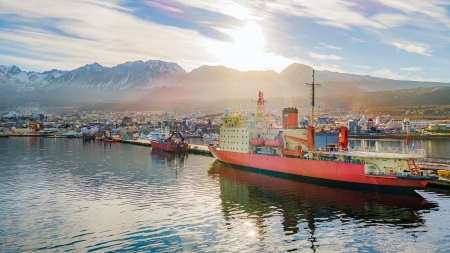The icebreaker ARA Almirante Irizar The second stage of the Antarctic Summer Campaign (CAV) will begin on Sunday, when setting sail from the city of Ushuaia in order to arrive, in approximately 12 days, to the Orcadas Base and the Belgrano II Baselocated on the white continent, where Navy personnel will carry out resupply tasks.
“We bring them all the materials so that they can be there during the Antarctic Winter Campaign (CAI),” said the commander of the vessel, Carlos Recio through a statement released by the Ministry of Defense.
During the campaign, in addition, the ship transfers the incoming staff and the personnel that withdraws after spending a year carrying out activities.
“When the Irízar arrives, we sound the typhoon, which is a great horn that is heard for kilometers and everyone comes out to say hello, it is something very exciting,” the captain anticipated about the arrival of the ship.

On the other hand, Recio stated that the giant iceberg that broke off of the Brunt ice barrier in the Argentine Antarctic Sector “is just one more stumbling block among the innumerable ones that exist” on the journey to the Antarctic bases.
“It’s just one more stumbling block among the innumerable ones in the Antarctic Campaign,” the ship’s captain told Télam, referring to the iceberg that was detected four days ago by the Naval Hydrography Service, dependent on the Ministry of Defending.
Monitoring the iceberg break
According to a statement from that service, the rupture of the giant iceberg occurred “in the south of the Weddell Sea, specifically the Brunt ice barrier, with an approximate area of 1,500 km2 equivalent to seven times the city of Buenos Aires.” the iceberg was named A81 and it was calculated that “It has an approximate draft of 150 meters”.
Recio affirmed that within the Irízar they are carrying out “monitoring tasks”since they have personnel from the Meteorology Department of the Naval Hydrography Service on board who “are specialists in everything related to monitoring ice movements.”

In this way, he was confident that “the iceberg is still in the immediate vicinity of the glacier”, but he affirmed that “if it leaves the normal route”, the Irízar has “advanced technology that allows its detection” in nearby areas.
“Once it is detected, we have two Naval Aviation helicopters that will allow us to visually determine the route to follow,” he explained in that regard.
Meanwhile, he stated that the icebreaker is “in contact” with the National Commission for Aerospace Activities of the Argentine Republic “which moved its surveillance area to that area.”
“This allows us to monitor the distance minute by minute and know what we are going to find when we are in the area of operations,” he emphasized.


















